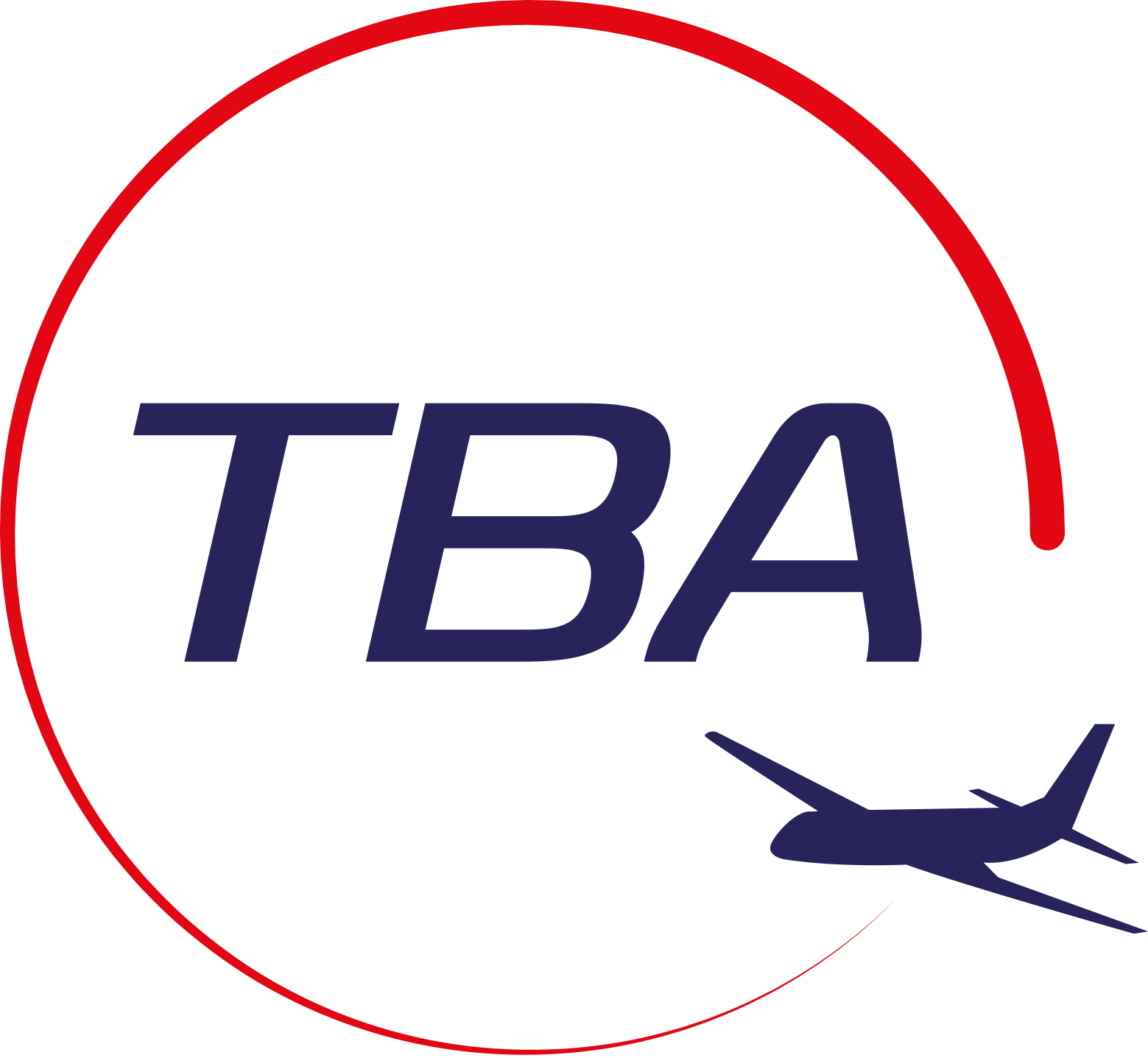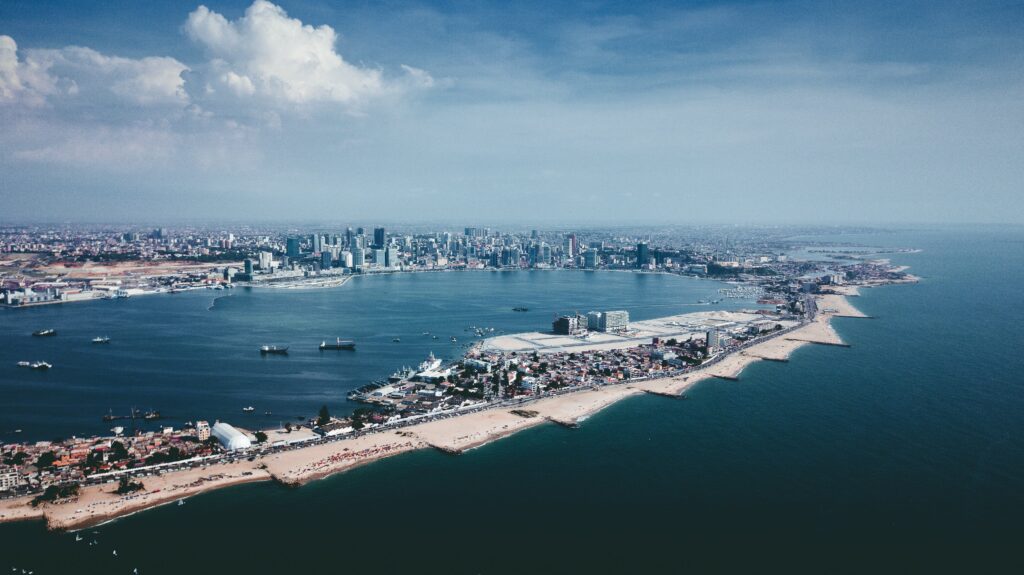
Research and knowledge are the first steps for Angola Travel Business Assistance. Here is a fact file for Angola to get you started. Contact us if you are looking to start a business in or expand your market to Angola. We have consultants ready to help you on the ground in Angola.
"Ready to expand your business globally? Schedule your free consultation with Travel Business Assistance today!"
The Basics on Angola
Origin of the name: During the first millennium A.D. peoples from Central Africa speaking languages in the Bantu moved into the area today known as Angola. By the end of the sixteenth century, the Bantu tribes controlled what is now Angola. There were two major tribal kingdoms, the Kongo and the Ndongo. The rulers of the Ndongo were called the Ngola and it is this word which is the origin of the name Angola.
History: The earliest known human inhabitants of the area were Khoisan hunter-gatherers. During the Bantu migrations, Bantu tribes largely replaced them, although Khoisans remained in southern Angola in small numbers. Arriving from the north, Bantu tribes likely came from near the area of the modern Republic of Cameroon. When the Bantu encountered the Khoisans in what is now Angola, they easily dominated them. The Khoisans were less advanced than the Bantu. Bantu establishment, which took centuries, gave rise to groups with different ethnic characteristics. These BaKongo kingdoms traded with other cities and peoples along the western and southwestern African coasts but did not trade across oceans. The Portuguese invaded the area now known as Angola in the late 15th century. After the Berlin Conference in 1885, fixing the colony’s borders, British and Portuguese investments in mining began to develop the backcountry. After nearly 500 years of Portuguese presence, independence calls were met with mixed reactions. In the 1950s, political organizations formed and began to demand rights in international forums like the Non-Aligned Movement. Portugal refused to give in to the demands of nationals for independence. In 1961, armed conflicts began when nationalist guerillas attacked civilians in northeastern Angola. The struggle was eventually named the Colonial War. The fighting and the 1974 coup d’état in Lisbon, overthrowing Marcelo Caetano’s regime, eventually earned Angola its independence on November 11, 1975.
Government: According to its Constitution adopted in 2010, last revised in 2021, Angola is a republic and unitary state with a presidential system. The Angolan government is formed by three separate branches, including legislative, executive, and judicial. The president, “the individual heading the national list of the political party or coalition of political parties which receives the most votes in general elections” (Art. 109), is the head of state and of the executive power, and the commander-in-chief of the Angolan Armed Forces. These three roles give the Angolan president a great range of political power, including the responsibility of appointing and the possibility to discharge all ministers, provincial governors, as well as all judges of the court system. Legislatively, the Angolan National Assembly is a unicameral parliament of members that are elected under a “universal, periodic suffrage by national citizens aged over eighteen”.
Official Language: The current language policy in Angola, as laid out in the Constitution of 2010, states that Portuguese is the official language (Const. of the Rep. of Angola, Article 19).
In urban areas, 85% of the population declared to speak Portuguese at home in the 2014 census, against 49% in rural areas. Portuguese was quickly adopted by Angolans in the mid-twentieth century as a lingua franca among the various ethnic groups.
Indigenous Languages: Portuguese is the only official language of Angola, but 46 other languages are spoken in the country, mostly Bantu languages. All native languages of Angola are considered to be national languages.
After independence, the government said it would choose six to be developed as literary languages. The six languages vary between government pronouncements, but commonly included are Umbundu, Kimbundu, Kikongo (presumably the Fiote of Cabinda), Chokwe, Kwanyama (Ovambo), and Mbunda (never clearly defined; maybe Nyemba, Luchazi, or indeterminate).
Angolan radio transmits in fourteen of the “main” national languages: Bangala (‘Mbangala’), Chokwe, Fiote, Herero (‘Helelo’), Kikongo, Kimbundu, Kwanyama, Lunda, Ngangela, Ngoya, Nyaneka, Ovambo (‘Oxiwambo’), Songo, Umbundu. Some of the national languages are used in Angolan schools, including the provision of teaching materials such as books.
Population: The current estimation of the Angolan population is 36,684,202 inhabitants (July 2023 estimates). Angola is the 41st most populated nation in the world, and the 12th most populous in Africa. Most people live in the western half of the country; urban areas account for the highest concentrations of people, particularly the capital of Luanda.
Time Zone: Angola currently observes West Africa Time (WAT). West Africa Time is consistent with UTC +1. Angola does not have an associated daylight-saving time. The West Africa Time applies to 14 countries: Algeria, Angola, Benin, Cameroon, Central African Republic, Chad, Democratic Republic of the Congo (Partly), Equatorial Guinea, Gabon, Morocco, Niger, Nigeria, Republic of the Congo, Tunisia.
Climate: Angola’s rainy season lasts from October to May and is characterized as hot and humid. The Inter-tropical Convergence Zone (ITCZ) controls rainfall as it moves between the equator and tropics, bringing rainfall to Angola as it migrates southward from the equator in October. The rains coincide with the warmest months of the year with average temperatures ranging from 22-23°C. The dry season, known as “Cacimbo,” occurs from June to September and is the coolest time of the year, with average temperatures between 18-20°C. Total rainfall decreases as you move from north to south and from east to west in Angola, with northeastern Angola receiving the most amount of rain. Located along the Atlantic Ocean, much of Angola’s climate is tied to sea surface temperatures and variations in the Benguela Cold Current.
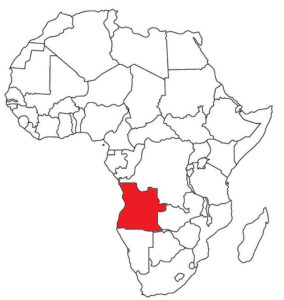 Borders: Angola’s neighboring countries are Democratic Republic of the Congo to the North, 2,646 km (of which 225 km is the boundary of discontiguous Cabinda Province); Republic of the Congo (Cabina exclave province); Namibia to the South; Zambia to the East. Angola has a 1,600km long coastline to the South Atlantic Ocean.
Borders: Angola’s neighboring countries are Democratic Republic of the Congo to the North, 2,646 km (of which 225 km is the boundary of discontiguous Cabinda Province); Republic of the Congo (Cabina exclave province); Namibia to the South; Zambia to the East. Angola has a 1,600km long coastline to the South Atlantic Ocean.
Geography note: The province of Cabinda is an exclave, separated from the rest of the country by the Democratic Republic of the Congo.
Size: The Total Angola area is about 1,246,700 sq km of which land: is 1,246,700 sq km and water is 0 sq km. Angola is about eight times the size of Georgia, or four times as big as Poland.
Religion: Angola’s population is overwhelmingly Christian. About two-fifths of the population is Roman Catholic, about two-fifths is Protestant, and some one-tenth adheres to traditional beliefs or other religions.
Currency: The kwanza (sign: Kz; ISO 4217 code: AOA) is the currency of Angola. The Kwanza was introduced in 1999, replacing the “Kwanza Reajustado” (AOK). AOA is subdivided into coin denominations of 100 cêntimos and is denoted by the symbol Kz.
- Central Bank: Banco Nacional de Angola
- Denominations:
- Bills: 200, 500, 1,000, 2,000, 5,000 kwanzas
- Coins Frequently used: 5, 10, 20, 50, 100, 200 kwanzas
- Coins Rarely used: 50 cêntimos, 1 kwanza
The current exchange rate is 832.799 Angolan Kwanza to 1 US Dollar, or 1,053.97 Angolan Kwanza to 1 Great British Pound (December 5th, 2023).
https://www.oanda.com/currency-converter/en/?from=AOA&to=USD&amount=832.799
https://www.oanda.com/currency-converter/en/?from=AOA&to=GBP&amount=1053.97
Angola History and Key Events
Precolonial & colonial Era
· 1300s – Kongo kingdom consolidates in the north.
· 1483 – Portuguese arrive.
· 16th-18th Centuries – Angola becomes a major Portuguese trading area for slaves.
· 1836 – The slave trade was officially abolished by the Portuguese government.
· 1956 – The early beginnings of the socialist guerrilla independence movement, the People’s Movement for the Liberation of Angola (MPLA), based in northern Congo.
· 1950s-1961 – Nationalist movement develops, guerrilla war begins.
· 1961 – Forced labour was abolished after revolts on coffee plantations. The fight for independence is bolstered.
· 1974 – Revolution in Portugal, its colonial empire collapses.
· 1975 – The Portuguese withdraw from Angola without formally handing power to any movement. MPLA is in control of Luanda and declares itself a government of independent Angola. Unita and FNLA set up a rival government in Huambo.
Independence
· 1976 – MPLA gains the upper hand.
· 1979 – MPLA leader Agostinho Neto dies. Jose Eduardo dos Santos takes over as president. He steps down 38 years later.
· 1987 – South African forces enter Angola to support Unita.
· 1988 – South Africa agrees to Namibian independence in exchange for the removal of Cuban troops from Angola.
· 1991 – Government, Unita sign peace accord in Lisbon.
· 1992 – Disputed elections. Fighting flares again.
· 1998 – Luanda launches offensive against Unita.
· 2002 – Unita leader Jonas Savimbi dies. The government and Unita signed a ceasefire shortly afterwards.
· 2004 – Oil production reaches one million barrels per day.
· 2012 – Angola launches a $5bn sovereign wealth fund to channel its oil wealth into investment projects.
· 2018 – Joao Lourenco becomes president.
Angolan Food
Angolan cuisine is like a delicious blend of Portuguese and Congolese flavors, thanks to its colonial history and neighboring influences. Funge takes the top spot as the favorite food, accompanied by rice, beans, and Kizaca leaves. You’ll find these tasty staples paired with many delightful dishes we’ll explore.
The most common ingredients used in the cuisine of Angola are tomatoes, garlic, palm oil, and beans. And because of the Atlantic Ocean and its vast territory, its cuisine offers a great variety of seafood and meats. Also, Angolan cuisine is known to be very saucy. Everything must have sauce so that when the meat or fish is finished, we still have the sauce to enjoy. Following is a list of tasty recipes, you’ll enjoy when visiting Angola.
Funge is the basic dish of the Angolan diet, and it’s the most popular food in the country. It is made of Fuba (flour) of corn or cassava (yuca). The northern region of Angola eats more Funge made of cassava, and the southern part eats more Funge of corn. Some people like the mixed version too, Funge of cassava and corn.
Calulu is a very common dish in Angolan cuisine. It can be made with fish or dried meat. It is usually served with Funge. Some people serve it with rice, but the experience is just not the same. Calulu is essentially made of fish or meat, sweet potato leaves, tomatoes, palm oil, and onions.
Fumbua is one of the dishes that is most consumed in the northern part of Angola and the neighboring country of the DRC. Fumbua are leaves that are collected from the forest and are very rich in vitamins. It can be found in restaurants, but it is mostly sold on the streets. It is cooked with boiling water and salt, palm oil, roasted peanuts, and seasoning.
Mukua is the fruit from the baobab tree originally from the northern part of Angola. It has a hard shell like a coconut. Inside the fruit, some seeds are coated with whitish powder, which is the fruit pulp. It has a unique taste and is used to make juices, mousses, and even cakes. Mukua juice can be made at home by putting the mukua in boiling water so that melts, and then adding sugar to it and letting it rest for hours.
Muzongué or Caldo is a dish made with fresh fish. It is mostly eaten in the morning after a party or celebration because it is good for hangovers. It is simply made by cutting the fish, Cacusso, or crab into cubes, seasoning it, and then boiling it. It is served with a combination of sweet potatoes and cassava, and red palm oil is added to it, giving it a sweet and salty flavor that fights the alcohol in the body if one is hungover. It is usually homemade and served in the mornings.
Mufete is the second most popular and delicious food in Angola after Funge. The composition is very straightforward. It is a combination of beans with palm or red oil, grilled fish, boiled plantains and sweet potatoes, chopped onion, and flour (Farinha). Mufete is usually made with Cacusso, a fish found on the shores of Luanda.
Jimboa is one of the most eaten vegetables present in Angolan cuisine. Originally from the southern region of Angola, this vegetable has a few health benefits. It is rich in fiber and proteins, which help fight against fat and gain muscle mass. It can be prepared with salt, vinegar, tomatoes, and sometimes palm oil, and then brought to a boil.
Makayabu is the Angolan name for dry fish. It is consumed a lot in Angola, but its origin is traced back to the Congo. The fish can be cacusso or codfish. Makayabu is often served with Funge, Kizaca, cabbage, or Calulu. The process involves first soaking it in water for 2 hours to remove the salt, after which it can be seasoned with salt, spices, tomato, vinegar, and cooking oil.
Cachupa is a hot exotic dish that originated from Cape Verde and has been adopted and modified by Angolans. It consists of a mix of various ingredients with beans being the main one. Similar to Mufete, this one is also mostly eaten on the weekends. It is a combination of beans, beef or pork, bacon, potatoes, cassava, and cabbage. It is then seasoned with the usual ingredients. Some people add corn and sweet potatoes to it to give it a light sweet flavor.
Catatos is a unique and unusual Angolan dish. At its most basic, the dish is made by frying caterpillars with garlic, but it can be enriched with the addition of onions, peppers, and tomatoes. The caterpillars should be quite tender but with a crunchy texture. Some say that they even taste like prawns. The dish is packed with nutritional value since caterpillars have a higher amount of protein and iron than fish or beef.
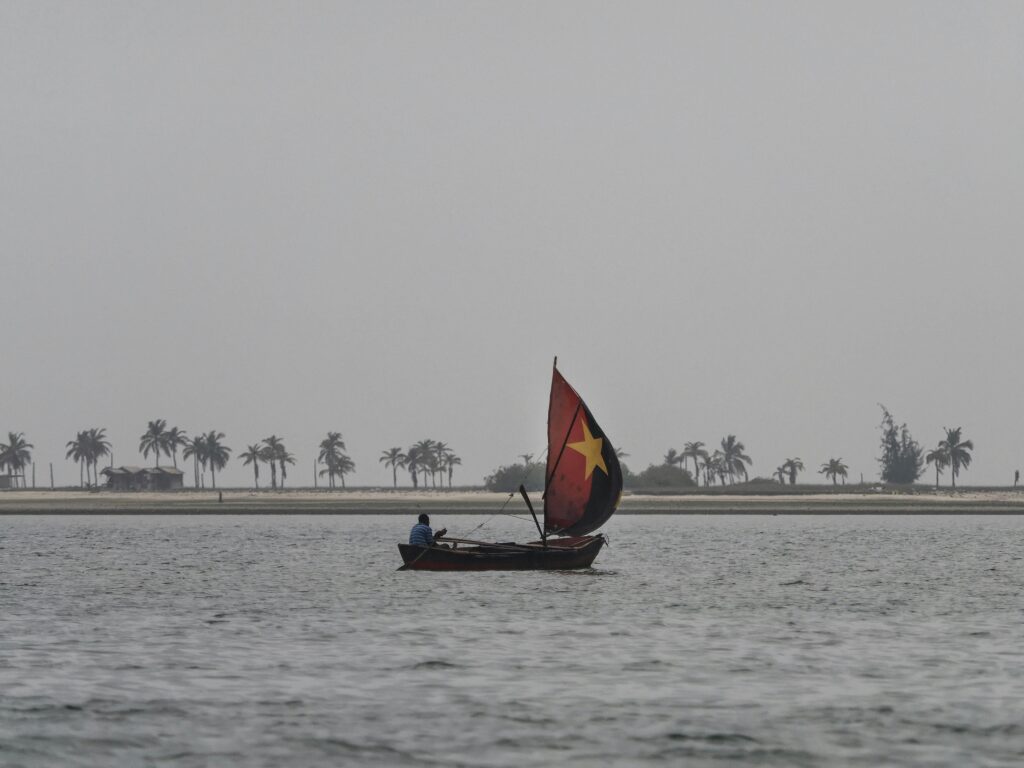
Things to do and see in Angola
Angola is a country with different climates, landscapes, cultures, and diversified Flora and Fauna. Its tourism industry is based on the country’s natural beauty, including its rivers, waterfalls, and a scenic coastline full of sandy beaches. The country has a geographic location of being in the inter-tropical and sub-tropical Southern hemispheres. In addition to its climatic diversity, Angola has a natural heritage made up of rich flora and fauna which makes the country a potential touristic destination for the practice of all sorts of leisure activities, hobbies, and adventures.
Angola has many unique amazing landscapes, among them the Kalandula Waterfalls and the Black Rocks of Pungo-a-Ndongo in Malanje province, the Leba Mountain scenic pass, and the Tundavala Gap in Huila Province as well as the Moon Viewpoint and the Kwanza River mouth in Luanda province.
During a visit to Angola, travelers can immerse themselves in the rich cultural experiences of the local communities. Angola is a country with a diverse cultural heritage, influenced by its history and various ethnic groups. One of the key cultural experiences
in Angola is the traditional music and dance. The country is known for its vibrant rhythms and energetic performances, which reflect the traditions and customs of the Angolan people.
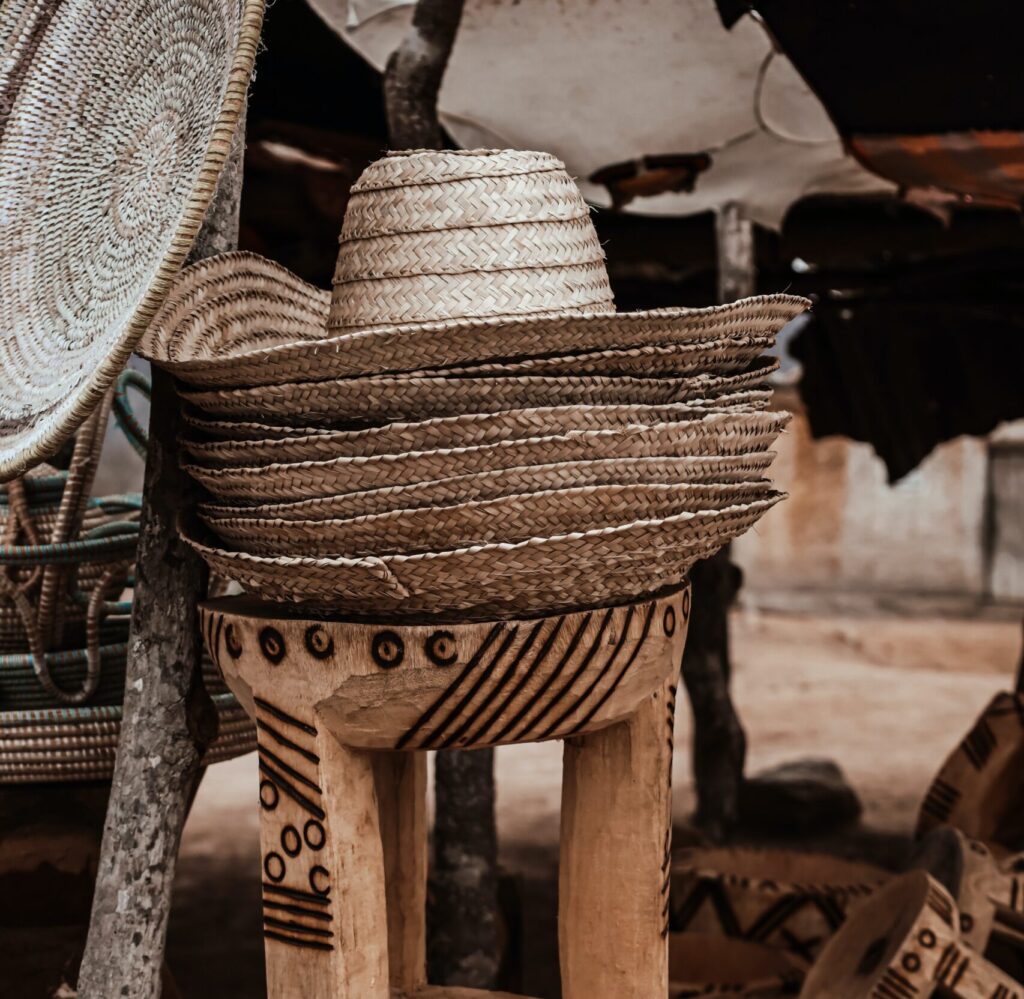
The Craft Market is the largest square in Angola where pieces that represent the national culture and a little of the history of Africa are sold, it is located in the south of Luanda, and the square has been operational for over 30 years, and its former location was in the Benfica district, currently, the market is located in Morro da Cruz, near the National Museum of Slavery.
Kalandula Falls is the biggest attraction in Malanje and probably in Angola. These falls are sometimes dubbed the 2nd most impressive in Africa (after Victoria Falls). Located in the Lucala River, the falls are over 100 meters high and 400 meters wide. These are particularly impressive during the rainy season when the Lucala is at full flow. One can hire a guide (usually a kid) to descend to the bottom, where the view and the proximity to the waterfall make the experience much more intense.
Lubango Festival is a 30-day celebration held in Lubango City in Angola’s Huila Province. Beginning in August, it features music performances, fashion parades, a sports tournament, motorbike racing, and the prestigious Miss Huila beauty pageant. The festival also kicks off the Expo-Huila trade show, along with some workshops and a cattle auction.
National Museum of Anthropology: This notable institution was founded on November 13, 1976, and is celebrated as a beacon of cultural and scientific significance, dedicating its mission to the collection, research, conservation, and dissemination of Angola’s rich cultural heritage. The museum is impressively structured across two floors and 14 rooms, housing a collection of over 6,000 traditional artifacts.
Baía Farta is a fishing village/town and loosely translates to a bay of plenty. With very few people, it’s very different from Baía Azul; however, the scenery is even better. As you approach the water, you realize the beautiful scenery and the privilege of having to yourself (or barely so) a world-class beach. After 300 meters of walking in the sand under the strong African sun, diving in that blue/turquoise and crystal clear is heavenly.
Angola’s Carnival Day is an annual celebration that typically falls on the Tuesday before Ash Wednesday in a three-day calendar of events. The carnival, a top attraction to tourists, proudly takes a seat as one of the Southern African nation’s most anticipated events. There are glamorous costumes and vibrant colors. Participants are embraced by nature, dancing without a care in the world. They will find a refreshing dose of culture, and a glorious parade to go with it. The tradition amazingly dates back to when it was a Portuguese colony.
Angola – Prehistoric Paintings: The Tchitundu Hulu Paintings are one of the finest collections of prehistoric rock engravings and paintings in the world and the only attraction of this kind in Angola. The paintings are found inside the caves and on a granite hill locally known as the “Sacred Hill of Mucuisses” in Capolopopo, about 137 km (85 miles) east of the city of Namibe, south of Angola.
Fishing: Angola offers great opportunities for sport fishing to those visitors who love recreational fishing, including big-game fishing conducted from boats to catch large open-water species such as tarpon, threadfin, tuna, and sailfish.
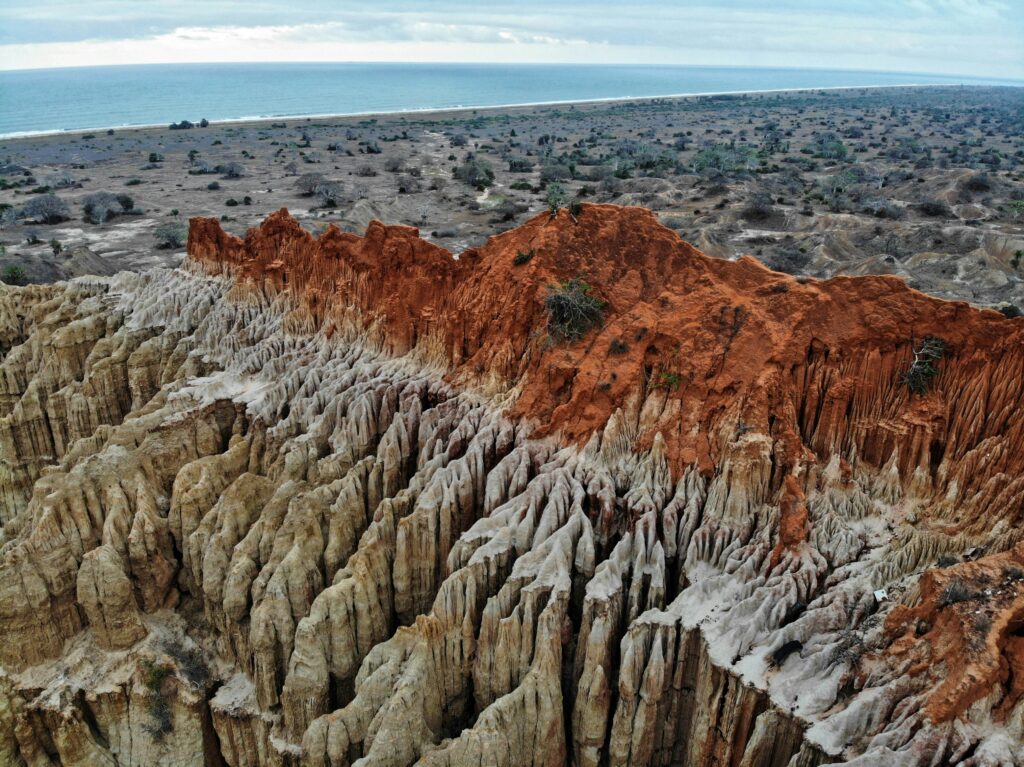
Miradouro da Lua (Viewpoint of the Moon): About 25 miles outside angola’s capital city of Luanda lies an otherworldly landscape. Erosion from wind and rain over thousands of years has carved canyons and ridges out of weathered rock just footsteps off the main road. Miradouro da Lua, Portuguese for “Viewpoint of the Moon,” shows off different colored strata of rock that wrap around an expansive panorama. Miradouro da Lua is the best location to see the full splendor of the moon-like landscape.
Angola Economy
Angola’s economy is overwhelmingly driven by its oil sector. Oil production and its supporting activities contribute about 50 percent of GDP, more than 70 percent of government revenue, and more than 90 percent of the country’s exports. Angola is an Organization of Petroleum Exporting Countries (OPEC) member and subject to its direction regarding oil production levels. Its oil production output is around 1.16 million barrels per day (bpd). Angola’s oil production surpassed that of Nigeria (1.02 million bpd in May), making it the largest oil producer in sub-Saharan Africa, despite showing declines from 1.18 million barrels per day. The country also holds significant proven gas reserves and extensive mineral resources. Diamonds represent 5 percent of exports. Subsistence agriculture provides the main livelihood for most of the people, but half of the country’s food is still imported.
The contribution of the non-oil sector to GDP growth is expected to reach 1.8% in 2023, thanks in particular to the extraction and export of diamonds, metals, and non-metallic minerals. Last, industry, agriculture, and fishing should benefit from the incentives put in place by President Joao Lourenço to reduce the country’s dependence on hydrocarbon prices. The briskness of these sectors, which employ more than 70% of the active population, should bolster private consumption, which has already been stimulated by a revaluation of civil service salaries and a 50% increase in the minimum wage.
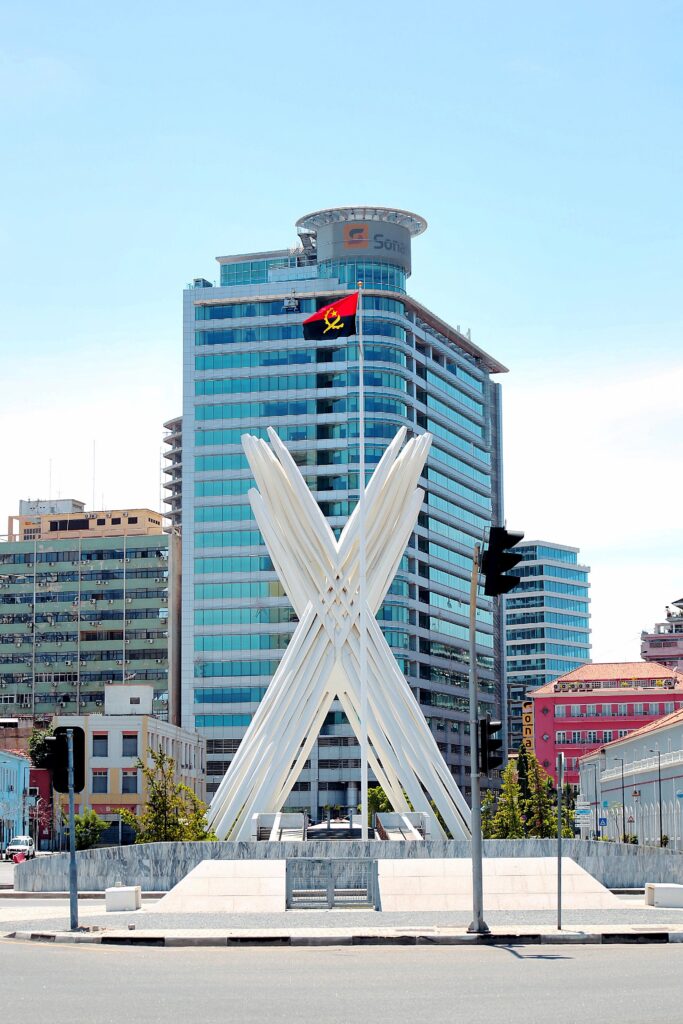
Doing Business in Angola
Ease of Doing Business Index Scores
Overall score: 41.3 (2020)
Starting a business score: 79.4 (2020)
Trading across Borders score: 36.2 (2020)
Enforcing Contracts score: 28.1 (2020)
Legal System:
The legal system is based on Portuguese civil law and customs law adapted to the local political pluralism. Foreigners are not discriminated against in any way but the Angolan legal system is not always impartial due to political influences. The language of Justice in Angola is Portuguese. The Angola Constitution guarantees the right to communicate in a language one understands, including via an interpreter.
Company creation procedures:
- Obtain a certificate of availability for the company name (certidão da firma) from the One-stop shop at the commercial registry (Ficheiro Central de Denominações Sociais), affiliated with the Ministry of Justice
- Pay the registration fee at the One-stop shop (Guichê Único da Empresa)
- Obtain the company’s articles of association at the One-stop shop (Guichê Único da Empresa)
- Obtain the company’s tax ID (NIF – National Identification Number) from Tax authorities at the One-stop shop (Guichê Único da Empresa)
- Notarize the company’s documents and register the company at the One-stop shop (Guichê Único da Empresa)
- Obtain the Commercial Operations Permit from the Ministry of Commerce at the One-stop shop (Guichê Único da Empresa)
- Legalize the company’s minutes book with the Commercial Registry
- Registration of employees with the National Social Security Institute (INSS)
Agência de Investimento Privado e Promoção das Exportações de Angola (AIPEX)
AIPEX – Angola’s Private Investment and Export Promotion Agency; is a legal entity governed by public law, endowed with legal personality, administrative, financial, and patrimonial autonomy, dedicated to promoting exports, attracting private investment, registering investment proposals, institutional support and monitoring the execution of investment projects and internationalization of Angolan companies.
It was created under Presidential Decree No. 81/18, of March 19, 2018, resulting from the merger of the Technical Unit for Private Investment – U.T.I.P and the Agency for Investment and Export Promotion of Angola – APIEX.
AIPEX is under the authority of the executive branch of the government, exercised through the Ministry of State for Economic Coordination.
Its mission is:
- Increase the participation of the non-oil private sector in the development of the national economy, through the Promotion and attraction of FDI;
- Ensure the development of competitiveness of national companies and promote their internationalization;
- Contribute to the implementation of policies and programs to replace imports and increase exports.
Its main responsibilities are:
- Promote and attract private investments of internal and external origin capable of contributing to the socio-economic development of Angola;
- Ensure the reception and monitoring of private investment proposals to be made in Angola;
- Promote the attraction of foreign direct investment for strategic sectors of the national economy;
- Promote the increase and diversification of exports of products and services from Angola;
- Contribute to the creation of favorable conditions for private investment in Angola;
- Supervise and control the execution of approved private investment projects.
- Execute policies and programs to replace imports and increase exports.
AIPEX is the investor’s sole interlocutor at all stages of the investment process. Through institutional coordination, it supports investors, monitors investment proposals, and ensures the conditions for the successful execution of investment projects.
Why invest in Angola
- MarketPotential.
o 31.1 million of Citizens
o GDP per capita US$ 3,484.60
o 300 million consumers in SADC
o Replace imports with Private Investment in
the priority sectors
- Key incentives
o 50M Hectares of Forest
o 35M Hectares of Arable Land (14% in use)
o 1650 KM of Coast and Irrigation Capacity of
7.5M Hectares
o SADC, AGOA, WTO, Africa Free Trade Agreement
o Diplomatic relations with 149 countries
o Privileged relations with border and other
Southern African countries
o Excellent relations with countries such as
China, the United States of America, Russia, Brazil, Portugal, France and the
United Arab Emirates
- Political commitment
- The government focused on attracting Private Investment
- Nem Private Investment Law 10/10
- Law of Competition
- Programs to encourage investment and diversification
- Social and Economic Stability
o Democracy and Free Elections
Investment Opportunities:
Mineral Resources: Angola is rich in mineral resources such as diamonds, iron, gold, and copper. There is great potential for investment in the exploration, development, and processing of these minerals. Angola is one of the largest diamond producers in the world and the main investment opportunities are in the development of mines, processing, and marketing capabilities. Opportunities in the iron, gold, and copper sectors are also available for those who are willing to invest in exploration.
Infrastructure Development: There is a significant gap in Angola’s infrastructure, and investment opportunities are available in transportation, energy, water and sanitation, and telecommunications. In transportation, opportunities include roads, bridges, ports, and airports to improve connectivity within the country. Some construction companies in Angola are working on connecting the country from north to south and extending access to rural areas. There is also a need for development in the transmission and distribution networks. The water and sanitation sectors, which are important issues for the population, hold opportunities in the development of dams, water treatment plants, and sewer systems. The telecommunications sector offers a large number of opportunities, especially in rural areas where access is more difficult. Opportunities are available in the development of broadband networks, mobile networks, and data centers. Real estate is also a potential investment opportunity in Angola, including the development of commercial and residential
properties, hotels, and resorts.
Agriculture: Due to Angola’s vast land resources, investment opportunities in the country are significant. Examples of opportunities include the production of crops such as corn, soybeans, and palm oil, as well as livestock production. The potential for development in the packaging and distribution of products, as well as in irrigation systems, storage facilities, and transportation networks is significant. Financing is also crucial in the sector, especially the provision of credit to small and medium-sized enterprises. This will help the sector grow and reduce the country’s dependence on imports. In the next five years, Angola could easily be on the list of main grain producers and will receive public investments to improve infrastructure access and make market entry easier.
Manufacturing: The consumer market in Angola is large, creating new opportunities in sectors such as food, beverages, household goods, and personal care products. Additionally, the demand for industrial goods is growing, boosting investment in machinery, equipment, and construction materials. The manufacturing sector also offers opportunities in other areas, such as the pharmaceutical industry, including generic drugs, and the automotive industry. This rapidly growing sector provides significant investment opportunities.
Tourism: Tourism in Angola is an important sector of the country, which boasts a diverse range of natural and cultural attractions. Given the natural beauty, wildlife, and cultural heritage on offer, investment in the sector is growing and it is considered an emerging market. Angola is also targeting sectors such as eco-tourism, seeking to take advantage of its national parks, forests, and beaches, as well as adventure tourism, including wildlife viewing, trekking, and water sports. There are some accommodations and hotels in the touristic areas, but not as much as might be needed should Angola manage to fight its way onto the beaten bath.
Energy – Oil, Gas & Hydropower: Angola is one of Africa’s main oil producers and there is a lot of investment potential both upstream and down. Angola’s reserves include both offshore and onshore deposits, although a dearth of transportation and storage infrastructure hampers growth. When it comes to renewable energy, Angola has some of the best potential for hydropower in Africa. Indeed, it could generate up to 20,000MW, although installed capacity currently only stands at 1,000MW. New large and small-scale projects are being developed, however, and this environmentally friendly source of energy is likely to continue attracting attention.
Angolan Flagship Projects
Caculo Cabaça Hydroelectric Project: The project includes the construction of a new dam with a 103-meter high wall and a capacity of 440 million cubic meters. The hydropower plant will have an installed capacity of 2.1 Gigawatts once completed in 2025. The power station is located in the village of São Pedro da Quilemba, near the city of Dondo, in Cuanza Norte Province. This location is approximately 195 kilometres (121 mi), by road, southeast of Luanda, the capital and largest city of Angola. The planned generation capacity at Caculo Cabaça is 2,172 megawatts, to be used in Angola and for export to the countries in the Southern African Power Pool.
Angola/Zambia Oil Pipeline (AZOP): In January 2023, Zambia and Angola agreed to accelerate the development of a $5 billion oil pipeline connecting the two nations. This landmark, still in the feasibility stage, will end more than a decade of complex negotiations and lead to more affordable fuel for Zambia. The private sector will develop the petroleum pipeline with Angolan state-owned company SONANGOL and Zambia’s Industrial Development Corporation-IDC Zambia, as strategic partners. Upon completion, expected in 2026, the AZOP will transport various petroleum products, including oil, diesel, kerosene, and gas.
Angola Travel Health Information
 Yellow fever vaccination certificate is required for travelers to Angola.
Yellow fever vaccination certificate is required for travelers to Angola.
It is strongly recommended that you visit a travel vaccination clinic and get other vaccinations.
COVID-19
Angola has dropped its COVID-19-related entry and exit requirements. As a result, there are no testing / proof of vaccination requirements for either entry or exit.
Angolan Immigration
Most other countries including the United States and the United Kingdom are required to obtain a visa before visiting Angola. The main requirements for eligibility include holding a current passport and providing proof of vaccination against yellow fever.
The passport must be valid with at least 6 months remaining before expiry and have a minimum of four consecutive free pages.
The e-visa provides pre-approval to receive your visa stamp when you enter the country. The e-visa can be used for both tourism and business visits. Detailed information is available at https://angola.org/online-visa/, while the visa application can be found at http://www.smevisa.gov.ao/
Angola Travel Business Assistance
Are you planning to move your business to Angola or open up Angola as a new market? Perhaps there is a conference in Angola you need to attend and you need some help. We are here for your Angola Travel Business Assistance.
